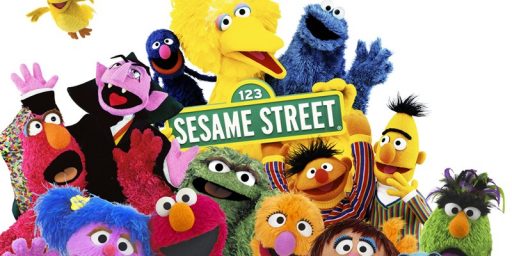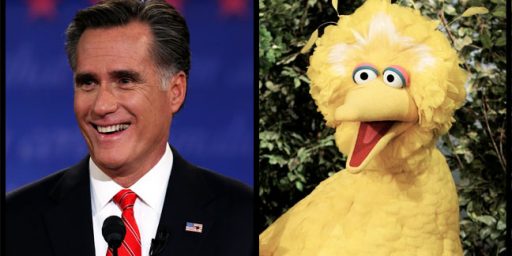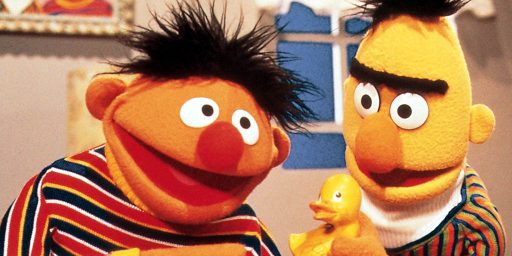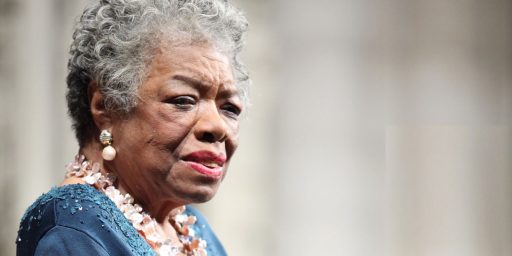Carroll Spinney, The Man Behind Big Bird, Dies At 85
A sad day for those of us who grew up watching Big Bird, Kermit, and the rest of the Muppets.

Carroll Spinney, the puppeteer behind two of Sesame Street’s most iconic characters, has died at the age of 85:
Caroll Spinney, the puppeteer who gave life to Big Bird, the towering yellow avian of TV’s “Sesame Street” who accompanied generations of youngsters in the arduous, yet wondrous, work of growing up, died Dec. 8 at his home in Connecticut. He was 85, and died hours before “Sesame Street” received a Kennedy Center Honor for achievement in the arts.
The production company Sesame Workshop announced his death and said he had dystonia, a neurological disorder affecting movement.
Decades before the advent of smartphones and tablets, when the “boob tube” was the boogeyman for parents and child psychologists fretting about what today is called screen time, Mr. Spinney brought his puppetry to a television show that aspired to be an educational influence on kids preschool-age and younger. It would become the longest-running children’s program on U.S. television.
“Sesame Street” debuted on public television in 1969, its curriculum undergirded by the research of the Children’s Television Workshop co-created by television producer Joan Ganz Cooney. The show featured a racially diverse cast of live actors, as well as animation and Jim Henson’s Muppets. It used advertising techniques including jingles and rhymes to teach children the alphabet and numbers, how to tie their shoes and brush their teeth, how to love a new sibling and confront a bully, and how to live in a community.
Mr. Spinney, who said he had been teased in childhood for his fascination with what his tormentors mocked as “dolls,” met Henson at a puppetry convention and first donned Big Bird’s 4,000 canary-yellow feathers for the show’s opening season. In thousands of episodes over nearly a half-century, he gave voice and motion to Big Bird and to Oscar the Grouch, the shaggy green trash can-dweller who showed children that they needed not always be happy and that it was okay to like things others didn’t — trash, for instance.The Muppets also included the thoughtful Bert and his playful friend Ernie, the ravenous Cookie Monster and giggling Elmo, who became a fan favorite particularly among the youngest “Sesame Street” viewers in the show’s later years. But Big Bird, who interacted most frequently with the human actors, remained the centerpiece of “Sesame Street,” a creature often bewildered by a world that was too small for him, much as children are confused by one that is too big.
Mr. Spinney brought to his character “a sensitivity to what childhood is like, what its challenges are, what its adventures are,” said Kathryn A. Ostrofsky, a scholar of media history who has studied the history of “Sesame Street.”
Big Bird became “the most human character of all the Muppets, the most nuanced, complex, most rounded,” she added. She attributed those qualities to Mr. Spinney’s acting ability, which she said “is something that people take for granted often when they think of puppeteers.”
Henson, who died in 1990, originally conceived Big Bird as a “funny, dumb country yokel,” Mr. Spinney said, recalling that he persuaded the show’s makers to recast the character as a curious 6-year-old. In creating Big Bird, Mr. Spinney said he drew from memories of his boyhood.
“I was very insecure, shy, didn’t know what to say to people,” he once told The Washington Post, recalling also that he was the smallest kid in school. “One time my teacher was asked what ‘puny’ was and she thought for a moment and said ‘Caroll. He’s puny.’ It’s probably just as bad to be too big, like Bird.”
Like many children, Big Bird had an invisible friend, called Mr. Snuffleupagus, although the woolly mammoth-like creature was eventually rendered visible to avoid suggesting to young viewers that their perceptions were not valid.
Often, Big Bird made mistakes so that children on the other side of the screen could learn from them, or jubilantly correct them, said Robert W. Morrow, author of the book ” ‘Sesame Street’ and the Reform of Children’s Television.” Other times, he posed questions that were unnatural for other characters to ask, the ones for which children most ardently sought answers.
In a memorable 1983 episode, “Sesame Street” viewers learned about the death of Mr. Hooper, the bowtie-bedecked shopkeeper played by actor Will Lee, who had died of a heart attack. The makers of the show considered having Mr. Hooper retire to Florida but ultimately decided to be honest with the children who had loved him.
“Big Bird, don’t you remember? We told you, Mr. Hooper died,” a human cast member reminds Big Bird, who, bearing a gift for his friend, had forgotten.
“Well, I’ll give it to him when he comes back,” Big Bird replies.
“Big Bird, Mr. Hooper’s not coming back,” another cast member explains. “When people die, they don’t come back.”
Slowly, Big Bird comes to understand.
“It won’t be the same,” he laments, his head low, his beak hanging toward the ground.
(…)
Carol Edwin Spinney was born in Waltham, Mass., on Dec. 26, 1933 — the day after Christmas, hence “Carol.” He later changed the spelling of his name.
Growing up in Acton, farther to the northwest of Boston, he was entranced by puppetry from an early age. His mother, who had designed clothing before raising two sons, made many of his first puppets. He recalled his father, who worked in a watch factory, as volatile and abusive.
Mr. Spinney said that he was ridiculed in his youth because of his feminine-sounding name and his large ears. But with puppetry “you can hide whatever you are at the moment and be only what they can see,” he once told the New York Times. “And you could get the adults to laugh.”
He made money working birthday parties and putting on shows, pocketing the proceeds for college. After attending art school in Boston, he served in the Air Force, then worked in Boston on a television show featuring Bozo the Clown before joining “Sesame Street.”
Mr. Spinney said that playing Big Bird sustained him through difficult periods of his life, including his divorce from his first wife, Janice, an event that he said caused him to contemplate suicide. In 1979, he married Debra Gilroy, who was a secretary for “Sesame Street.” He had three children from his first marriage, Jessica, Melissa and Benjamin. Complete information on survivors was not immediately available.
Such was the appeal of Big Bird that NASA asked Mr. Spinney to fly intoorbit in costume, to interest young people in space exploration. Mr. Spinney agreed to go, but it was ultimately determined that the space shuttle was too small to accommodate the Big Bird suit. A New Hampshire teacher, Christa McAuliffe, went in his stead and was killed along with the rest of the crew when the Challenger shuttle exploded in 1986.
As Mr. Spinney grew older, Big Bird became perceptibly stooped. Because of balance problems, he stopped doing puppetry for Big Bird, although he continued providing the bird’s voice, in 2015. Mr. Spinney retired from the show in 2018, by which time he had collected a slew of awards including a Lifetime Achievement Award at the Daytime Emmys in 2006
(…)
Mr. Spinney, who was succeeded as Big Bird by an apprentice, Matt Vogel, appeared in scores of “Sesame Street” movies, videos and recordings.
Many children, he came to understand, believed in Big Bird as intensely as they believed in Santa Claus. He regarded it as his sacred duty to preserve the illusion, for as long as possible.
“If they come to the set I get ‘deBirded’ eventually and some take it very hard,” he told The Post years ago. “I’ve seen a lot of disappointment. I know it’s going to happen sooner or later, but I hate it. Childhood fantasy is a precious, short-lived time; don’t take it away. The reality of the world is going to be apparent all too soon.”
Sesame Street started at PBS one year after I was born and, like many generations of children that followed, Big Bird was probably the most relatable character on the show precisely because of the way that Spinney persuaded to play him, as child-like and innocent to the realities of the world. (Spinney’s other major puppet, Oscar The Grouch, has come to epitomize adulthood for many of I think, but that’s another story entirely,) At the time, the character was as real as the human actors on the show. Obviously, I stopped watching the show a long time ago now, but along with Mr. Rodgers Neighborhood, Sesame Street was a big part of growing up back then.






Sad news.
Big Bird finally gets to join Kermit in the big Street in the Sky.
Another gut punch. :-/
I was one of those sensitive kids who really appreciated both Big Bird and Mister Rogers growing up.